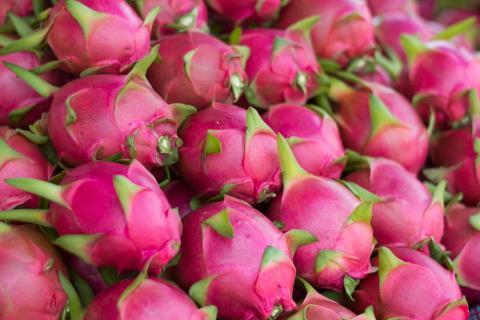
Pitaya is a member of the family Cactaceae, commonly known as the Cactus family of the genus Hylocereus (A. Berger) Britton & Rose or nightblooming cactus P and contains three species, the Hylocereus costaricensis (F.A.C. Weber) Britton & Rose or Costa Rica nightblooming cactus P, the Hylocereus trigonus (Haw.) Saff. or strawberry-pear P, and the Hylocereus undatus (Haw.) Britton & Rose, also known as the nightblooming cactus P.
The plant is native to Central America and was a staple food of the people of the region in the 13th century, as documented in Aztec literature. The French brought the plant to Vietnam, where it is known as “thang loy.” Pitaya, also known as dragon fruit, was introduced in Malaysia in the late 20th century. Today, the plant has several names that include Moonflower, Queen of the Night, the Cinderella plant, Belle of the Night, and Night Blooming Cereus.
The pitaya cactus blooms once a year, briefly at night, but produces fruit four to six times a year. Its fruit is highly nutritious and is not only a versatile food but also a healing herb. These short-lived flowers are primarily pollenated by bats but moths can also pollinate them and they can be hand pollenated.
Pitaya is produced by a climbing cactus that grows stems that can reach almost twenty feet in height. The fruit can be oval or oblong, weighs from eight to twelve ounces, and can be up to five inches in length. The outer skin or peel ranges in color from pink to magenta with green leaves that appear to have scales. The flesh is white and speckled with tiny black edible seeds, and the dense pulp has a juicy and spongy texture. The flavor of the fruit is subtly sweet, much like berries, pear, kiwi, and watermelon, and offers a slight tartness.
Health Benefits of Pitaya
Pitaya is rich in nutrients that include vitamins C, B1, B2, and B3; it also contains calcium, iron, phosphorous, and sodium. Other nutrients found in the fruit are dietary fiber and antioxidants, proteins, a small amount of fat, and sugar.
There are several health benefits in adding pitaya to a diet. Because it is rich in antioxidants and low in calories it is an ideal snack for those on a weight loss diet. These antioxidants are also a factor in reducing the risk of developing various cancers and help to boost the immune system. The sugars found in the fruit are known as oligosaccharides and studies have shown that they help the body produce good bacteria which aids in digestion. The plant fiber found in pitaya bulks the solid wastes and stimulates the peristaltic movement of the intestines which induces the release of digestive juices. Thus, pitaya reduces the development of constipation, irritable bowel syndrome, and colorectal cancer.
Other health benefits of pitaya include regulating blood sugars which can reduce the risk of developing diabetes. The iron present in the fruit helps the body produce red blood cells, resulting in the prevention of anemia. Pitaya is rich in magnesium and has no saturated fats which increases the good cholesterol (HDL) and reduces the bad cholesterol (LDL), lowering the risk of developing cardiovascular diseases and heart attacks and strokes. Its protein content speeds up cell repair, increases muscle mass, and strengthens the metabolism.
How To Grow Pitaya
Growing pitaya is moderately easy and they can be started from seed or grown from a cutting. It can be included in gardens in warm climates or potted in colder climates. To grow dragon fruit from seed, moisten a paper towel and place notched seeds in moistened paper towels overnight before planting in starter pots, and be sure to keep the soil moist until germination, which can be from fifteen to thirty days.
Growing the plant from cuttings is recommended for large yield gardens. To grow potted plants, use the appropriate size pot. A five-gallon pot is a good starter container and should be ten to twelve inches deep. The cactus must be transplanted into larger pots annually as it grows; a mature plant would need a twenty-five to thirty-gallon pot that is twenty to twenty-four inches deep. The container should be kept in full sunlight and because it is a climbing cactus it would need support to accommodate the growth.
Eating Pitaya
Pitaya is a versatile fruit with many applications. It can be eaten raw, either sliced or spooned out and chilled. It makes an excellent refreshing juice and can be an ingredient in cocktails. It is a healthy addition to ice cream-based cocktails or can be fermented to make other alcoholic drinks. It can be used as a substitute for rice by individuals that have diabetes.








